Analysis of Depression and Obesity in ACU Student Health Study, 2019
VerifiedAdded on 2022/11/13
|12
|2956
|94
Report
AI Summary
This report presents an analysis of the relationship between depression and obesity among adolescents, using data from the Longitudinal Survey of ACU Student Health and Well-being. The study, conducted as part of PUBH620, investigates the correlation between baseline depression symptoms and the subsequent development of obesity over a three-year period. The research employs a cohort study design and utilizes the Center for Epidemiologic Studies Depression Scale (CES-D) and BMI measurements to assess participants. The findings reveal a significant association: adolescents exhibiting depression at baseline demonstrated an increased likelihood of becoming obese during the follow-up period. Various covariates, including age, gender, race, parental obesity, and socioeconomic status, were considered in the analysis. The odds ratio for developing obesity, given baseline depression, was found to be 2.25 with a 95% confidence level. The report concludes that addressing adolescent depression could be a key strategy in preventing obesity, emphasizing the importance of early intervention and mental health support. The study highlights the importance of understanding the bidirectional nature of depression and obesity and the potential for interventions to mitigate the risks associated with these conditions.

1
Running Head: Depression And Obesity
Depression And Obesity
Student Name
Student ID
Running Head: Depression And Obesity
Depression And Obesity
Student Name
Student ID
Paraphrase This Document
Need a fresh take? Get an instant paraphrase of this document with our AI Paraphraser
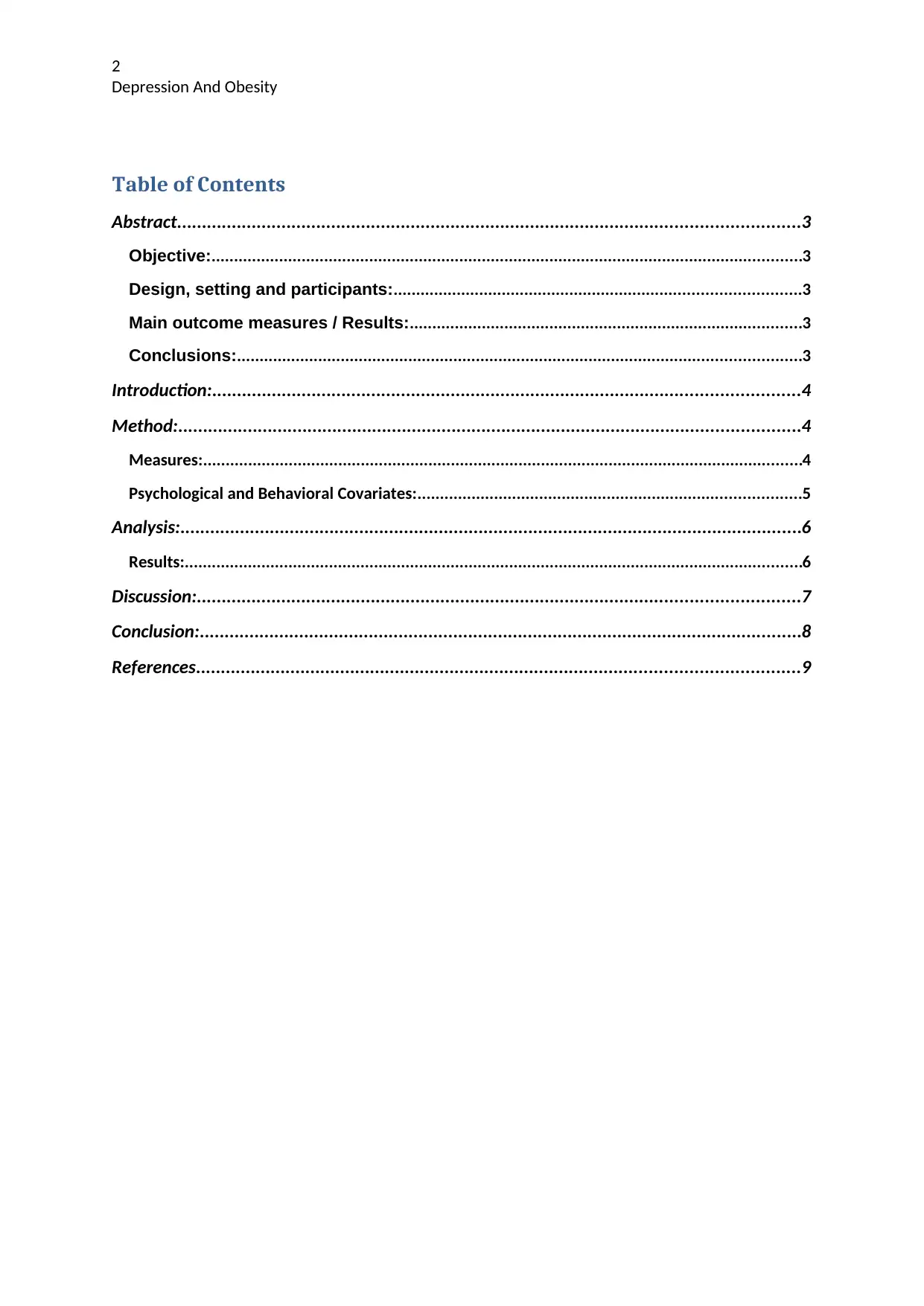
2
Depression And Obesity
Table of Contents
Abstract.............................................................................................................................3
Objective:...................................................................................................................................3
Design, setting and participants:..........................................................................................3
Main outcome measures / Results:.......................................................................................3
Conclusions:.............................................................................................................................3
Introduction:......................................................................................................................4
Method:.............................................................................................................................4
Measures:.....................................................................................................................................4
Psychological and Behavioral Covariates:.....................................................................................5
Analysis:.............................................................................................................................6
Results:.........................................................................................................................................6
Discussion:.........................................................................................................................7
Conclusion:.........................................................................................................................8
References.........................................................................................................................9
Depression And Obesity
Table of Contents
Abstract.............................................................................................................................3
Objective:...................................................................................................................................3
Design, setting and participants:..........................................................................................3
Main outcome measures / Results:.......................................................................................3
Conclusions:.............................................................................................................................3
Introduction:......................................................................................................................4
Method:.............................................................................................................................4
Measures:.....................................................................................................................................4
Psychological and Behavioral Covariates:.....................................................................................5
Analysis:.............................................................................................................................6
Results:.........................................................................................................................................6
Discussion:.........................................................................................................................7
Conclusion:.........................................................................................................................8
References.........................................................................................................................9
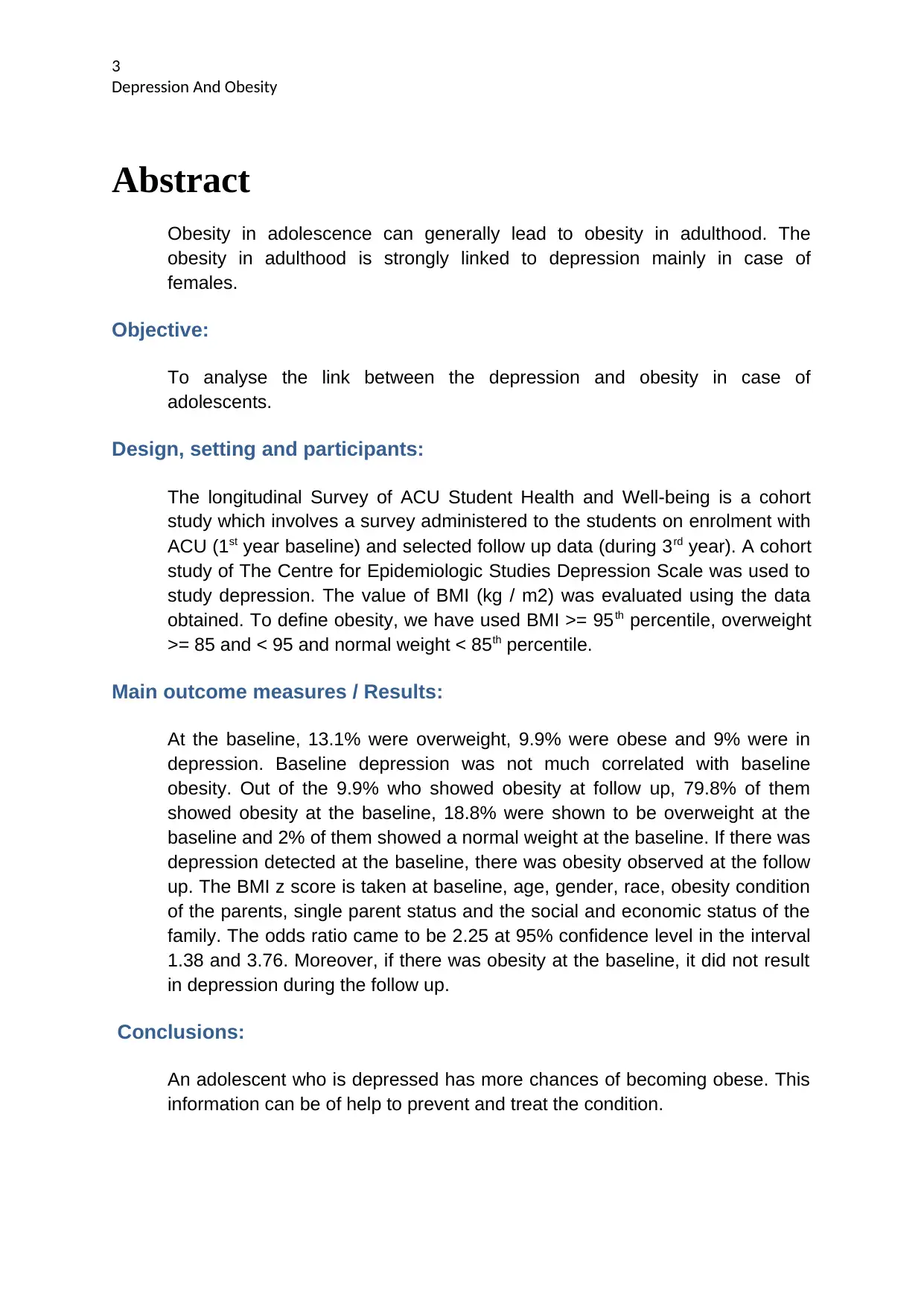
3
Depression And Obesity
Abstract
Obesity in adolescence can generally lead to obesity in adulthood. The
obesity in adulthood is strongly linked to depression mainly in case of
females.
Objective:
To analyse the link between the depression and obesity in case of
adolescents.
Design, setting and participants:
The longitudinal Survey of ACU Student Health and Well-being is a cohort
study which involves a survey administered to the students on enrolment with
ACU (1st year baseline) and selected follow up data (during 3rd year). A cohort
study of The Centre for Epidemiologic Studies Depression Scale was used to
study depression. The value of BMI (kg / m2) was evaluated using the data
obtained. To define obesity, we have used BMI >= 95th percentile, overweight
>= 85 and < 95 and normal weight < 85th percentile.
Main outcome measures / Results:
At the baseline, 13.1% were overweight, 9.9% were obese and 9% were in
depression. Baseline depression was not much correlated with baseline
obesity. Out of the 9.9% who showed obesity at follow up, 79.8% of them
showed obesity at the baseline, 18.8% were shown to be overweight at the
baseline and 2% of them showed a normal weight at the baseline. If there was
depression detected at the baseline, there was obesity observed at the follow
up. The BMI z score is taken at baseline, age, gender, race, obesity condition
of the parents, single parent status and the social and economic status of the
family. The odds ratio came to be 2.25 at 95% confidence level in the interval
1.38 and 3.76. Moreover, if there was obesity at the baseline, it did not result
in depression during the follow up.
Conclusions:
An adolescent who is depressed has more chances of becoming obese. This
information can be of help to prevent and treat the condition.
Depression And Obesity
Abstract
Obesity in adolescence can generally lead to obesity in adulthood. The
obesity in adulthood is strongly linked to depression mainly in case of
females.
Objective:
To analyse the link between the depression and obesity in case of
adolescents.
Design, setting and participants:
The longitudinal Survey of ACU Student Health and Well-being is a cohort
study which involves a survey administered to the students on enrolment with
ACU (1st year baseline) and selected follow up data (during 3rd year). A cohort
study of The Centre for Epidemiologic Studies Depression Scale was used to
study depression. The value of BMI (kg / m2) was evaluated using the data
obtained. To define obesity, we have used BMI >= 95th percentile, overweight
>= 85 and < 95 and normal weight < 85th percentile.
Main outcome measures / Results:
At the baseline, 13.1% were overweight, 9.9% were obese and 9% were in
depression. Baseline depression was not much correlated with baseline
obesity. Out of the 9.9% who showed obesity at follow up, 79.8% of them
showed obesity at the baseline, 18.8% were shown to be overweight at the
baseline and 2% of them showed a normal weight at the baseline. If there was
depression detected at the baseline, there was obesity observed at the follow
up. The BMI z score is taken at baseline, age, gender, race, obesity condition
of the parents, single parent status and the social and economic status of the
family. The odds ratio came to be 2.25 at 95% confidence level in the interval
1.38 and 3.76. Moreover, if there was obesity at the baseline, it did not result
in depression during the follow up.
Conclusions:
An adolescent who is depressed has more chances of becoming obese. This
information can be of help to prevent and treat the condition.
⊘ This is a preview!⊘
Do you want full access?
Subscribe today to unlock all pages.

Trusted by 1+ million students worldwide
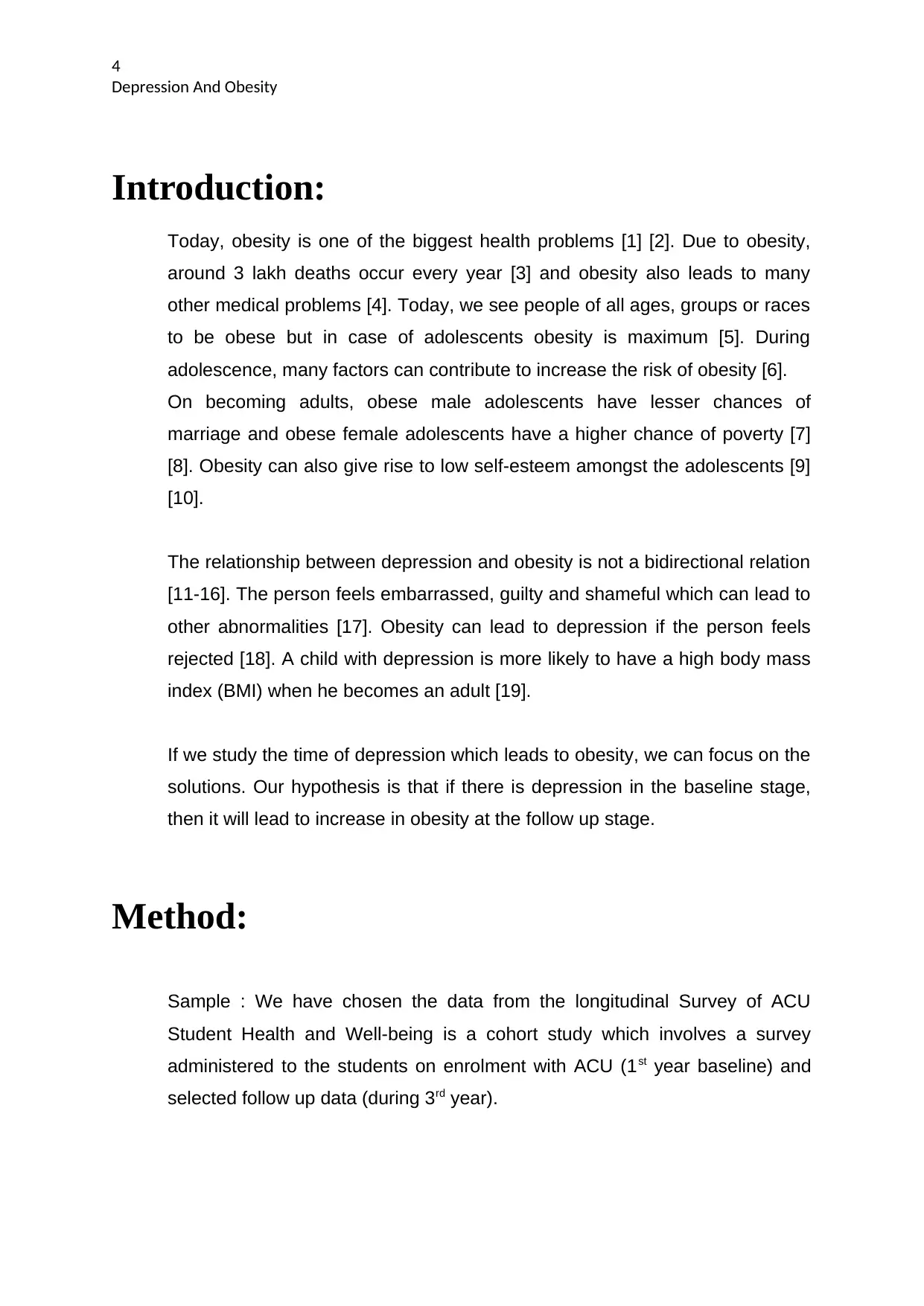
4
Depression And Obesity
Introduction:
Today, obesity is one of the biggest health problems [1] [2]. Due to obesity,
around 3 lakh deaths occur every year [3] and obesity also leads to many
other medical problems [4]. Today, we see people of all ages, groups or races
to be obese but in case of adolescents obesity is maximum [5]. During
adolescence, many factors can contribute to increase the risk of obesity [6].
On becoming adults, obese male adolescents have lesser chances of
marriage and obese female adolescents have a higher chance of poverty [7]
[8]. Obesity can also give rise to low self-esteem amongst the adolescents [9]
[10].
The relationship between depression and obesity is not a bidirectional relation
[11-16]. The person feels embarrassed, guilty and shameful which can lead to
other abnormalities [17]. Obesity can lead to depression if the person feels
rejected [18]. A child with depression is more likely to have a high body mass
index (BMI) when he becomes an adult [19].
If we study the time of depression which leads to obesity, we can focus on the
solutions. Our hypothesis is that if there is depression in the baseline stage,
then it will lead to increase in obesity at the follow up stage.
Method:
Sample : We have chosen the data from the longitudinal Survey of ACU
Student Health and Well-being is a cohort study which involves a survey
administered to the students on enrolment with ACU (1st year baseline) and
selected follow up data (during 3rd year).
Depression And Obesity
Introduction:
Today, obesity is one of the biggest health problems [1] [2]. Due to obesity,
around 3 lakh deaths occur every year [3] and obesity also leads to many
other medical problems [4]. Today, we see people of all ages, groups or races
to be obese but in case of adolescents obesity is maximum [5]. During
adolescence, many factors can contribute to increase the risk of obesity [6].
On becoming adults, obese male adolescents have lesser chances of
marriage and obese female adolescents have a higher chance of poverty [7]
[8]. Obesity can also give rise to low self-esteem amongst the adolescents [9]
[10].
The relationship between depression and obesity is not a bidirectional relation
[11-16]. The person feels embarrassed, guilty and shameful which can lead to
other abnormalities [17]. Obesity can lead to depression if the person feels
rejected [18]. A child with depression is more likely to have a high body mass
index (BMI) when he becomes an adult [19].
If we study the time of depression which leads to obesity, we can focus on the
solutions. Our hypothesis is that if there is depression in the baseline stage,
then it will lead to increase in obesity at the follow up stage.
Method:
Sample : We have chosen the data from the longitudinal Survey of ACU
Student Health and Well-being is a cohort study which involves a survey
administered to the students on enrolment with ACU (1st year baseline) and
selected follow up data (during 3rd year).
Paraphrase This Document
Need a fresh take? Get an instant paraphrase of this document with our AI Paraphraser
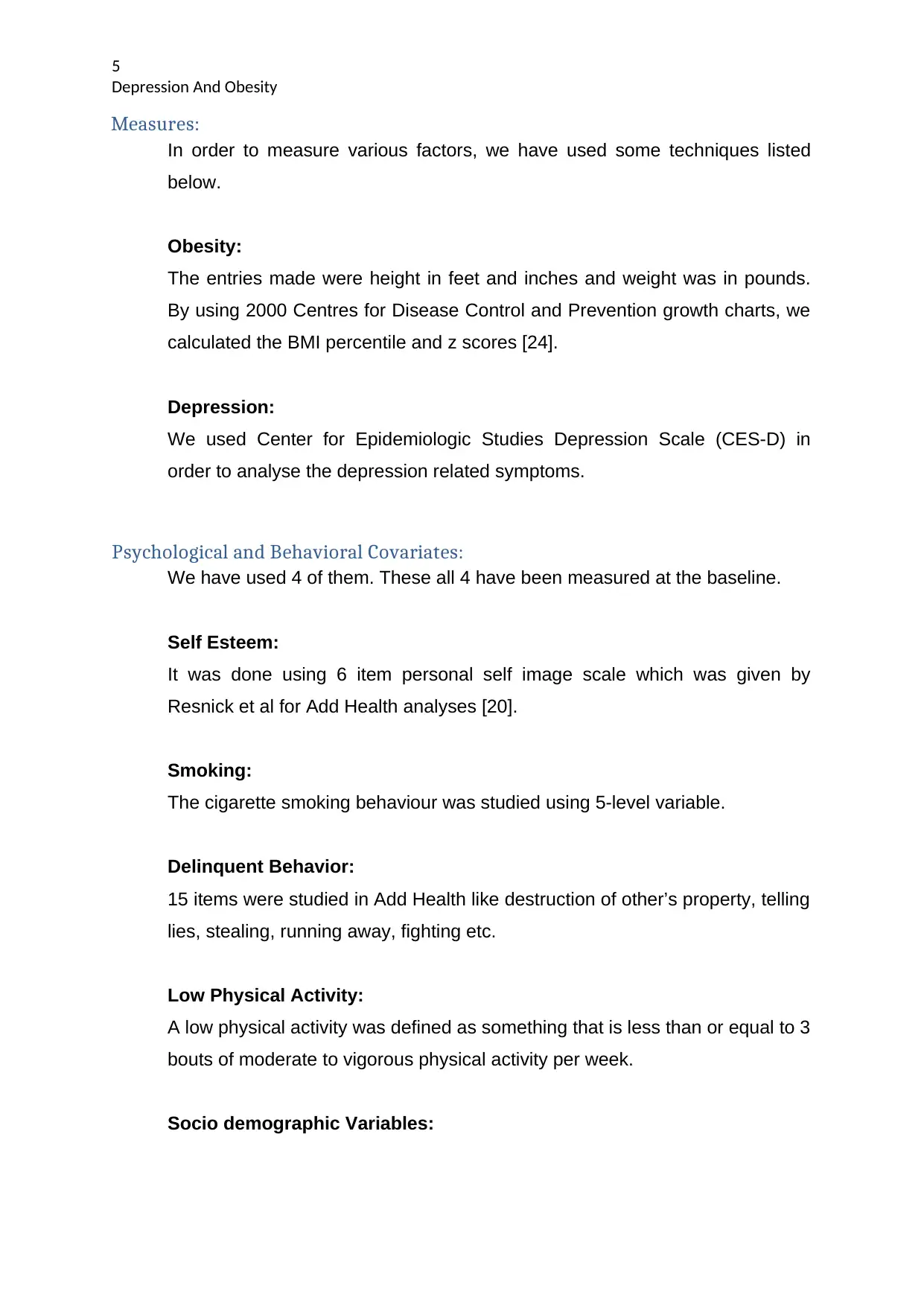
5
Depression And Obesity
Measures:
In order to measure various factors, we have used some techniques listed
below.
Obesity:
The entries made were height in feet and inches and weight was in pounds.
By using 2000 Centres for Disease Control and Prevention growth charts, we
calculated the BMI percentile and z scores [24].
Depression:
We used Center for Epidemiologic Studies Depression Scale (CES-D) in
order to analyse the depression related symptoms.
Psychological and Behavioral Covariates:
We have used 4 of them. These all 4 have been measured at the baseline.
Self Esteem:
It was done using 6 item personal self image scale which was given by
Resnick et al for Add Health analyses [20].
Smoking:
The cigarette smoking behaviour was studied using 5-level variable.
Delinquent Behavior:
15 items were studied in Add Health like destruction of other’s property, telling
lies, stealing, running away, fighting etc.
Low Physical Activity:
A low physical activity was defined as something that is less than or equal to 3
bouts of moderate to vigorous physical activity per week.
Socio demographic Variables:
Depression And Obesity
Measures:
In order to measure various factors, we have used some techniques listed
below.
Obesity:
The entries made were height in feet and inches and weight was in pounds.
By using 2000 Centres for Disease Control and Prevention growth charts, we
calculated the BMI percentile and z scores [24].
Depression:
We used Center for Epidemiologic Studies Depression Scale (CES-D) in
order to analyse the depression related symptoms.
Psychological and Behavioral Covariates:
We have used 4 of them. These all 4 have been measured at the baseline.
Self Esteem:
It was done using 6 item personal self image scale which was given by
Resnick et al for Add Health analyses [20].
Smoking:
The cigarette smoking behaviour was studied using 5-level variable.
Delinquent Behavior:
15 items were studied in Add Health like destruction of other’s property, telling
lies, stealing, running away, fighting etc.
Low Physical Activity:
A low physical activity was defined as something that is less than or equal to 3
bouts of moderate to vigorous physical activity per week.
Socio demographic Variables:
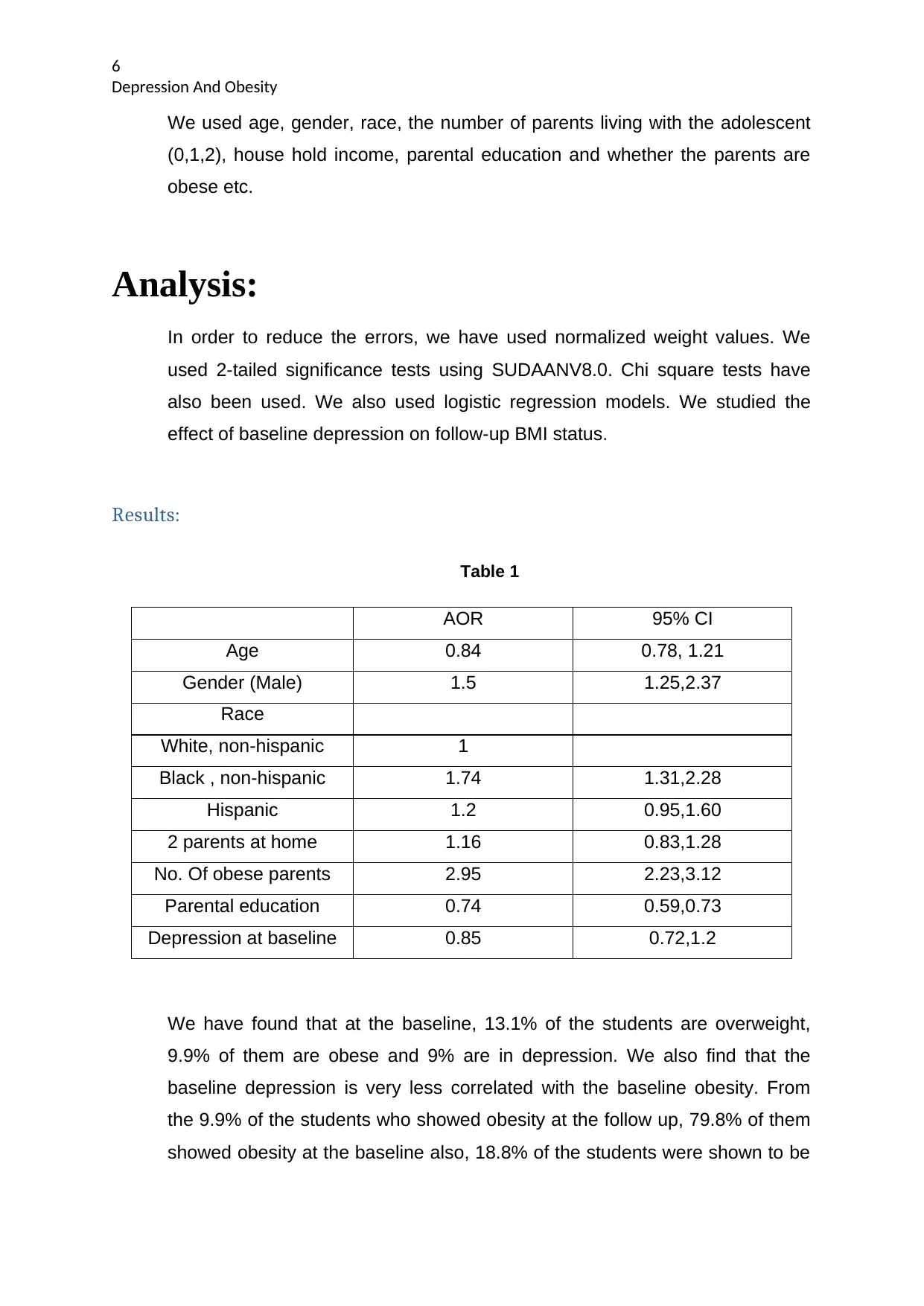
6
Depression And Obesity
We used age, gender, race, the number of parents living with the adolescent
(0,1,2), house hold income, parental education and whether the parents are
obese etc.
Analysis:
In order to reduce the errors, we have used normalized weight values. We
used 2-tailed significance tests using SUDAANV8.0. Chi square tests have
also been used. We also used logistic regression models. We studied the
effect of baseline depression on follow-up BMI status.
Results:
Table 1
AOR 95% CI
Age 0.84 0.78, 1.21
Gender (Male) 1.5 1.25,2.37
Race
White, non-hispanic 1
Black , non-hispanic 1.74 1.31,2.28
Hispanic 1.2 0.95,1.60
2 parents at home 1.16 0.83,1.28
No. Of obese parents 2.95 2.23,3.12
Parental education 0.74 0.59,0.73
Depression at baseline 0.85 0.72,1.2
We have found that at the baseline, 13.1% of the students are overweight,
9.9% of them are obese and 9% are in depression. We also find that the
baseline depression is very less correlated with the baseline obesity. From
the 9.9% of the students who showed obesity at the follow up, 79.8% of them
showed obesity at the baseline also, 18.8% of the students were shown to be
Depression And Obesity
We used age, gender, race, the number of parents living with the adolescent
(0,1,2), house hold income, parental education and whether the parents are
obese etc.
Analysis:
In order to reduce the errors, we have used normalized weight values. We
used 2-tailed significance tests using SUDAANV8.0. Chi square tests have
also been used. We also used logistic regression models. We studied the
effect of baseline depression on follow-up BMI status.
Results:
Table 1
AOR 95% CI
Age 0.84 0.78, 1.21
Gender (Male) 1.5 1.25,2.37
Race
White, non-hispanic 1
Black , non-hispanic 1.74 1.31,2.28
Hispanic 1.2 0.95,1.60
2 parents at home 1.16 0.83,1.28
No. Of obese parents 2.95 2.23,3.12
Parental education 0.74 0.59,0.73
Depression at baseline 0.85 0.72,1.2
We have found that at the baseline, 13.1% of the students are overweight,
9.9% of them are obese and 9% are in depression. We also find that the
baseline depression is very less correlated with the baseline obesity. From
the 9.9% of the students who showed obesity at the follow up, 79.8% of them
showed obesity at the baseline also, 18.8% of the students were shown to be
⊘ This is a preview!⊘
Do you want full access?
Subscribe today to unlock all pages.

Trusted by 1+ million students worldwide
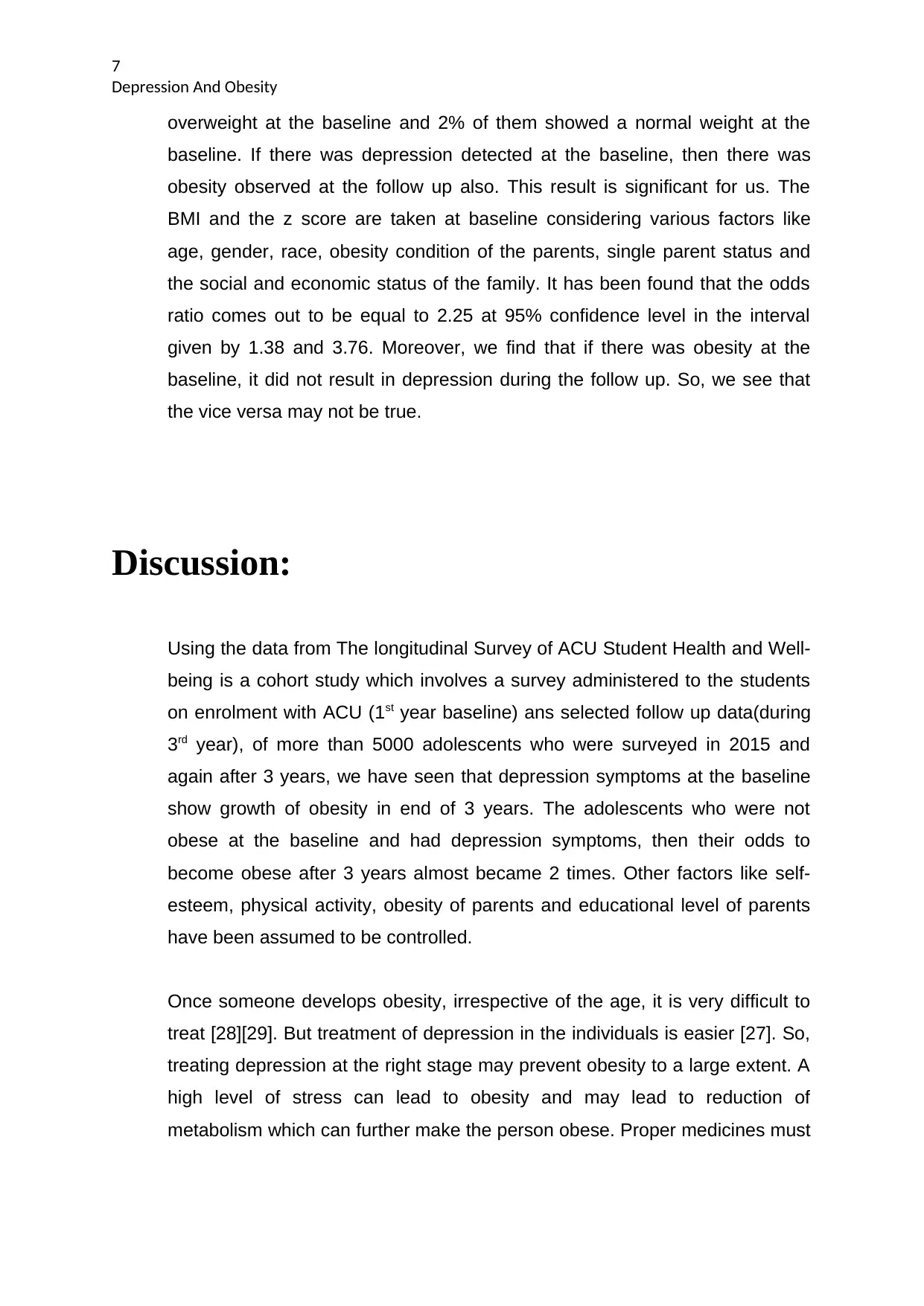
7
Depression And Obesity
overweight at the baseline and 2% of them showed a normal weight at the
baseline. If there was depression detected at the baseline, then there was
obesity observed at the follow up also. This result is significant for us. The
BMI and the z score are taken at baseline considering various factors like
age, gender, race, obesity condition of the parents, single parent status and
the social and economic status of the family. It has been found that the odds
ratio comes out to be equal to 2.25 at 95% confidence level in the interval
given by 1.38 and 3.76. Moreover, we find that if there was obesity at the
baseline, it did not result in depression during the follow up. So, we see that
the vice versa may not be true.
Discussion:
Using the data from The longitudinal Survey of ACU Student Health and Well-
being is a cohort study which involves a survey administered to the students
on enrolment with ACU (1st year baseline) ans selected follow up data(during
3rd year), of more than 5000 adolescents who were surveyed in 2015 and
again after 3 years, we have seen that depression symptoms at the baseline
show growth of obesity in end of 3 years. The adolescents who were not
obese at the baseline and had depression symptoms, then their odds to
become obese after 3 years almost became 2 times. Other factors like self-
esteem, physical activity, obesity of parents and educational level of parents
have been assumed to be controlled.
Once someone develops obesity, irrespective of the age, it is very difficult to
treat [28][29]. But treatment of depression in the individuals is easier [27]. So,
treating depression at the right stage may prevent obesity to a large extent. A
high level of stress can lead to obesity and may lead to reduction of
metabolism which can further make the person obese. Proper medicines must
Depression And Obesity
overweight at the baseline and 2% of them showed a normal weight at the
baseline. If there was depression detected at the baseline, then there was
obesity observed at the follow up also. This result is significant for us. The
BMI and the z score are taken at baseline considering various factors like
age, gender, race, obesity condition of the parents, single parent status and
the social and economic status of the family. It has been found that the odds
ratio comes out to be equal to 2.25 at 95% confidence level in the interval
given by 1.38 and 3.76. Moreover, we find that if there was obesity at the
baseline, it did not result in depression during the follow up. So, we see that
the vice versa may not be true.
Discussion:
Using the data from The longitudinal Survey of ACU Student Health and Well-
being is a cohort study which involves a survey administered to the students
on enrolment with ACU (1st year baseline) ans selected follow up data(during
3rd year), of more than 5000 adolescents who were surveyed in 2015 and
again after 3 years, we have seen that depression symptoms at the baseline
show growth of obesity in end of 3 years. The adolescents who were not
obese at the baseline and had depression symptoms, then their odds to
become obese after 3 years almost became 2 times. Other factors like self-
esteem, physical activity, obesity of parents and educational level of parents
have been assumed to be controlled.
Once someone develops obesity, irrespective of the age, it is very difficult to
treat [28][29]. But treatment of depression in the individuals is easier [27]. So,
treating depression at the right stage may prevent obesity to a large extent. A
high level of stress can lead to obesity and may lead to reduction of
metabolism which can further make the person obese. Proper medicines must
Paraphrase This Document
Need a fresh take? Get an instant paraphrase of this document with our AI Paraphraser
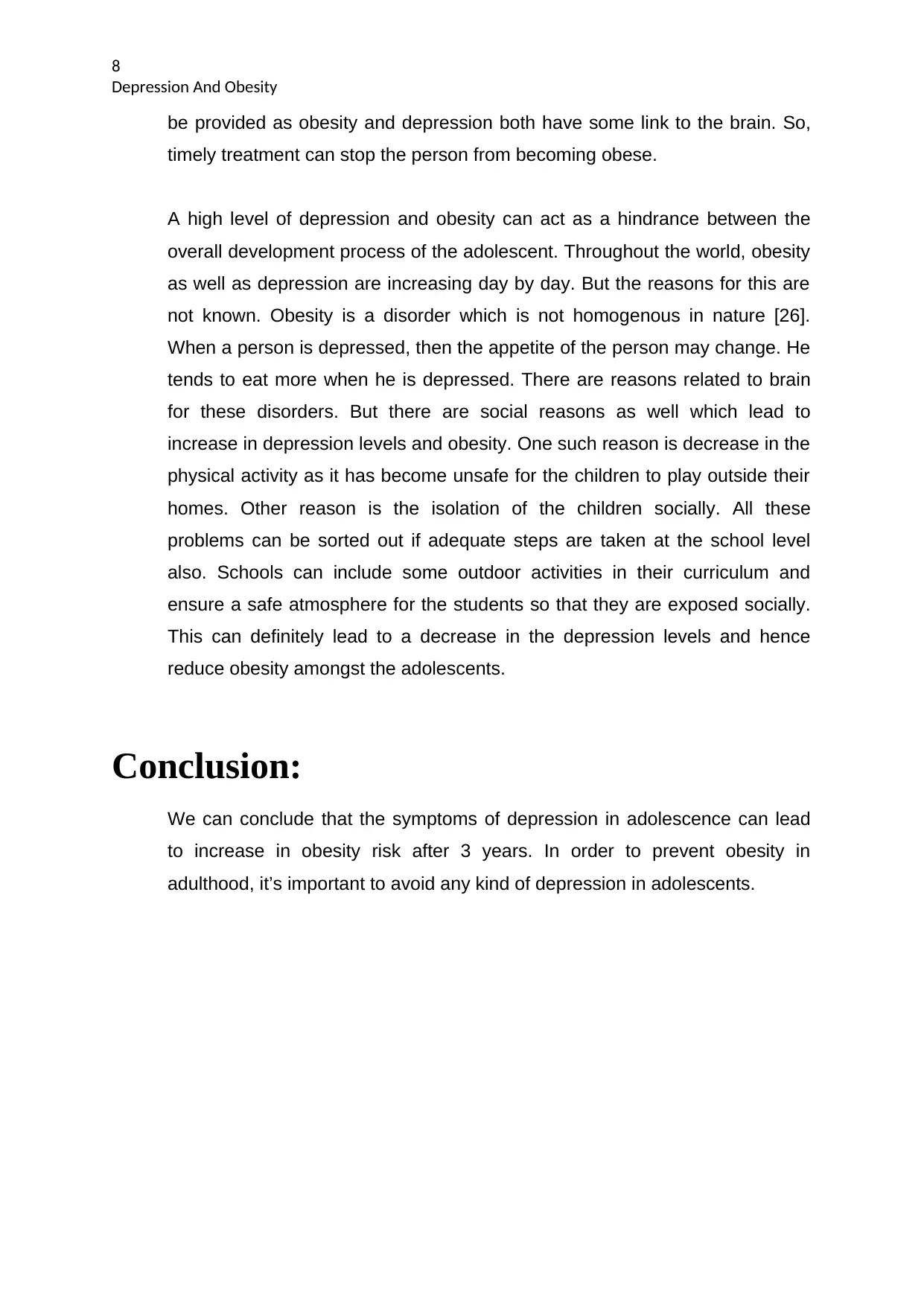
8
Depression And Obesity
be provided as obesity and depression both have some link to the brain. So,
timely treatment can stop the person from becoming obese.
A high level of depression and obesity can act as a hindrance between the
overall development process of the adolescent. Throughout the world, obesity
as well as depression are increasing day by day. But the reasons for this are
not known. Obesity is a disorder which is not homogenous in nature [26].
When a person is depressed, then the appetite of the person may change. He
tends to eat more when he is depressed. There are reasons related to brain
for these disorders. But there are social reasons as well which lead to
increase in depression levels and obesity. One such reason is decrease in the
physical activity as it has become unsafe for the children to play outside their
homes. Other reason is the isolation of the children socially. All these
problems can be sorted out if adequate steps are taken at the school level
also. Schools can include some outdoor activities in their curriculum and
ensure a safe atmosphere for the students so that they are exposed socially.
This can definitely lead to a decrease in the depression levels and hence
reduce obesity amongst the adolescents.
Conclusion:
We can conclude that the symptoms of depression in adolescence can lead
to increase in obesity risk after 3 years. In order to prevent obesity in
adulthood, it’s important to avoid any kind of depression in adolescents.
Depression And Obesity
be provided as obesity and depression both have some link to the brain. So,
timely treatment can stop the person from becoming obese.
A high level of depression and obesity can act as a hindrance between the
overall development process of the adolescent. Throughout the world, obesity
as well as depression are increasing day by day. But the reasons for this are
not known. Obesity is a disorder which is not homogenous in nature [26].
When a person is depressed, then the appetite of the person may change. He
tends to eat more when he is depressed. There are reasons related to brain
for these disorders. But there are social reasons as well which lead to
increase in depression levels and obesity. One such reason is decrease in the
physical activity as it has become unsafe for the children to play outside their
homes. Other reason is the isolation of the children socially. All these
problems can be sorted out if adequate steps are taken at the school level
also. Schools can include some outdoor activities in their curriculum and
ensure a safe atmosphere for the students so that they are exposed socially.
This can definitely lead to a decrease in the depression levels and hence
reduce obesity amongst the adolescents.
Conclusion:
We can conclude that the symptoms of depression in adolescence can lead
to increase in obesity risk after 3 years. In order to prevent obesity in
adulthood, it’s important to avoid any kind of depression in adolescents.
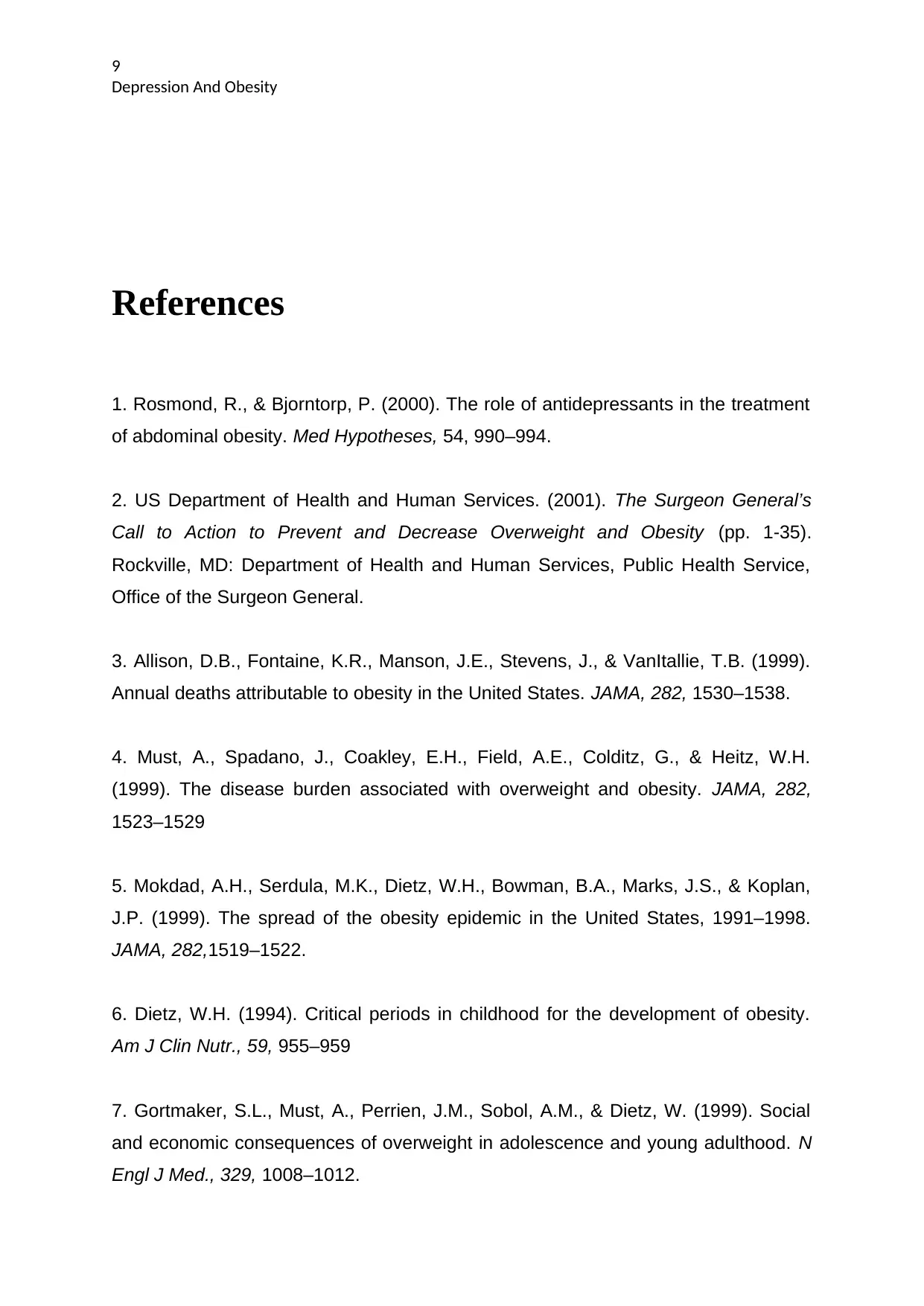
9
Depression And Obesity
References
1. Rosmond, R., & Bjorntorp, P. (2000). The role of antidepressants in the treatment
of abdominal obesity. Med Hypotheses, 54, 990–994.
2. US Department of Health and Human Services. (2001). The Surgeon General’s
Call to Action to Prevent and Decrease Overweight and Obesity (pp. 1-35).
Rockville, MD: Department of Health and Human Services, Public Health Service,
Office of the Surgeon General.
3. Allison, D.B., Fontaine, K.R., Manson, J.E., Stevens, J., & VanItallie, T.B. (1999).
Annual deaths attributable to obesity in the United States. JAMA, 282, 1530–1538.
4. Must, A., Spadano, J., Coakley, E.H., Field, A.E., Colditz, G., & Heitz, W.H.
(1999). The disease burden associated with overweight and obesity. JAMA, 282,
1523–1529
5. Mokdad, A.H., Serdula, M.K., Dietz, W.H., Bowman, B.A., Marks, J.S., & Koplan,
J.P. (1999). The spread of the obesity epidemic in the United States, 1991–1998.
JAMA, 282,1519–1522.
6. Dietz, W.H. (1994). Critical periods in childhood for the development of obesity.
Am J Clin Nutr., 59, 955–959
7. Gortmaker, S.L., Must, A., Perrien, J.M., Sobol, A.M., & Dietz, W. (1999). Social
and economic consequences of overweight in adolescence and young adulthood. N
Engl J Med., 329, 1008–1012.
Depression And Obesity
References
1. Rosmond, R., & Bjorntorp, P. (2000). The role of antidepressants in the treatment
of abdominal obesity. Med Hypotheses, 54, 990–994.
2. US Department of Health and Human Services. (2001). The Surgeon General’s
Call to Action to Prevent and Decrease Overweight and Obesity (pp. 1-35).
Rockville, MD: Department of Health and Human Services, Public Health Service,
Office of the Surgeon General.
3. Allison, D.B., Fontaine, K.R., Manson, J.E., Stevens, J., & VanItallie, T.B. (1999).
Annual deaths attributable to obesity in the United States. JAMA, 282, 1530–1538.
4. Must, A., Spadano, J., Coakley, E.H., Field, A.E., Colditz, G., & Heitz, W.H.
(1999). The disease burden associated with overweight and obesity. JAMA, 282,
1523–1529
5. Mokdad, A.H., Serdula, M.K., Dietz, W.H., Bowman, B.A., Marks, J.S., & Koplan,
J.P. (1999). The spread of the obesity epidemic in the United States, 1991–1998.
JAMA, 282,1519–1522.
6. Dietz, W.H. (1994). Critical periods in childhood for the development of obesity.
Am J Clin Nutr., 59, 955–959
7. Gortmaker, S.L., Must, A., Perrien, J.M., Sobol, A.M., & Dietz, W. (1999). Social
and economic consequences of overweight in adolescence and young adulthood. N
Engl J Med., 329, 1008–1012.
⊘ This is a preview!⊘
Do you want full access?
Subscribe today to unlock all pages.

Trusted by 1+ million students worldwide
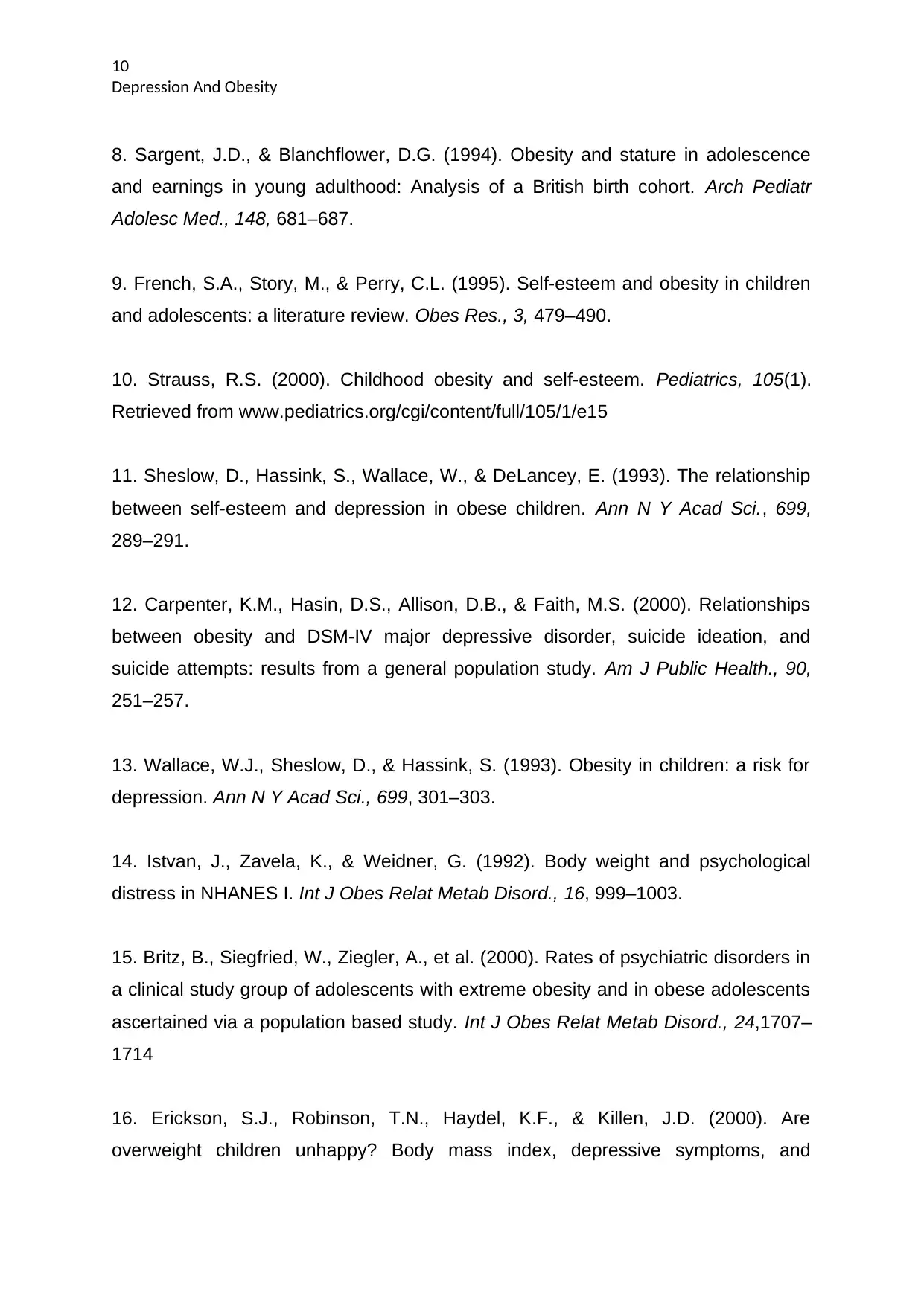
10
Depression And Obesity
8. Sargent, J.D., & Blanchflower, D.G. (1994). Obesity and stature in adolescence
and earnings in young adulthood: Analysis of a British birth cohort. Arch Pediatr
Adolesc Med., 148, 681–687.
9. French, S.A., Story, M., & Perry, C.L. (1995). Self-esteem and obesity in children
and adolescents: a literature review. Obes Res., 3, 479–490.
10. Strauss, R.S. (2000). Childhood obesity and self-esteem. Pediatrics, 105(1).
Retrieved from www.pediatrics.org/cgi/content/full/105/1/e15
11. Sheslow, D., Hassink, S., Wallace, W., & DeLancey, E. (1993). The relationship
between self-esteem and depression in obese children. Ann N Y Acad Sci., 699,
289–291.
12. Carpenter, K.M., Hasin, D.S., Allison, D.B., & Faith, M.S. (2000). Relationships
between obesity and DSM-IV major depressive disorder, suicide ideation, and
suicide attempts: results from a general population study. Am J Public Health., 90,
251–257.
13. Wallace, W.J., Sheslow, D., & Hassink, S. (1993). Obesity in children: a risk for
depression. Ann N Y Acad Sci., 699, 301–303.
14. Istvan, J., Zavela, K., & Weidner, G. (1992). Body weight and psychological
distress in NHANES I. Int J Obes Relat Metab Disord., 16, 999–1003.
15. Britz, B., Siegfried, W., Ziegler, A., et al. (2000). Rates of psychiatric disorders in
a clinical study group of adolescents with extreme obesity and in obese adolescents
ascertained via a population based study. Int J Obes Relat Metab Disord., 24,1707–
1714
16. Erickson, S.J., Robinson, T.N., Haydel, K.F., & Killen, J.D. (2000). Are
overweight children unhappy? Body mass index, depressive symptoms, and
Depression And Obesity
8. Sargent, J.D., & Blanchflower, D.G. (1994). Obesity and stature in adolescence
and earnings in young adulthood: Analysis of a British birth cohort. Arch Pediatr
Adolesc Med., 148, 681–687.
9. French, S.A., Story, M., & Perry, C.L. (1995). Self-esteem and obesity in children
and adolescents: a literature review. Obes Res., 3, 479–490.
10. Strauss, R.S. (2000). Childhood obesity and self-esteem. Pediatrics, 105(1).
Retrieved from www.pediatrics.org/cgi/content/full/105/1/e15
11. Sheslow, D., Hassink, S., Wallace, W., & DeLancey, E. (1993). The relationship
between self-esteem and depression in obese children. Ann N Y Acad Sci., 699,
289–291.
12. Carpenter, K.M., Hasin, D.S., Allison, D.B., & Faith, M.S. (2000). Relationships
between obesity and DSM-IV major depressive disorder, suicide ideation, and
suicide attempts: results from a general population study. Am J Public Health., 90,
251–257.
13. Wallace, W.J., Sheslow, D., & Hassink, S. (1993). Obesity in children: a risk for
depression. Ann N Y Acad Sci., 699, 301–303.
14. Istvan, J., Zavela, K., & Weidner, G. (1992). Body weight and psychological
distress in NHANES I. Int J Obes Relat Metab Disord., 16, 999–1003.
15. Britz, B., Siegfried, W., Ziegler, A., et al. (2000). Rates of psychiatric disorders in
a clinical study group of adolescents with extreme obesity and in obese adolescents
ascertained via a population based study. Int J Obes Relat Metab Disord., 24,1707–
1714
16. Erickson, S.J., Robinson, T.N., Haydel, K.F., & Killen, J.D. (2000). Are
overweight children unhappy? Body mass index, depressive symptoms, and
Paraphrase This Document
Need a fresh take? Get an instant paraphrase of this document with our AI Paraphraser
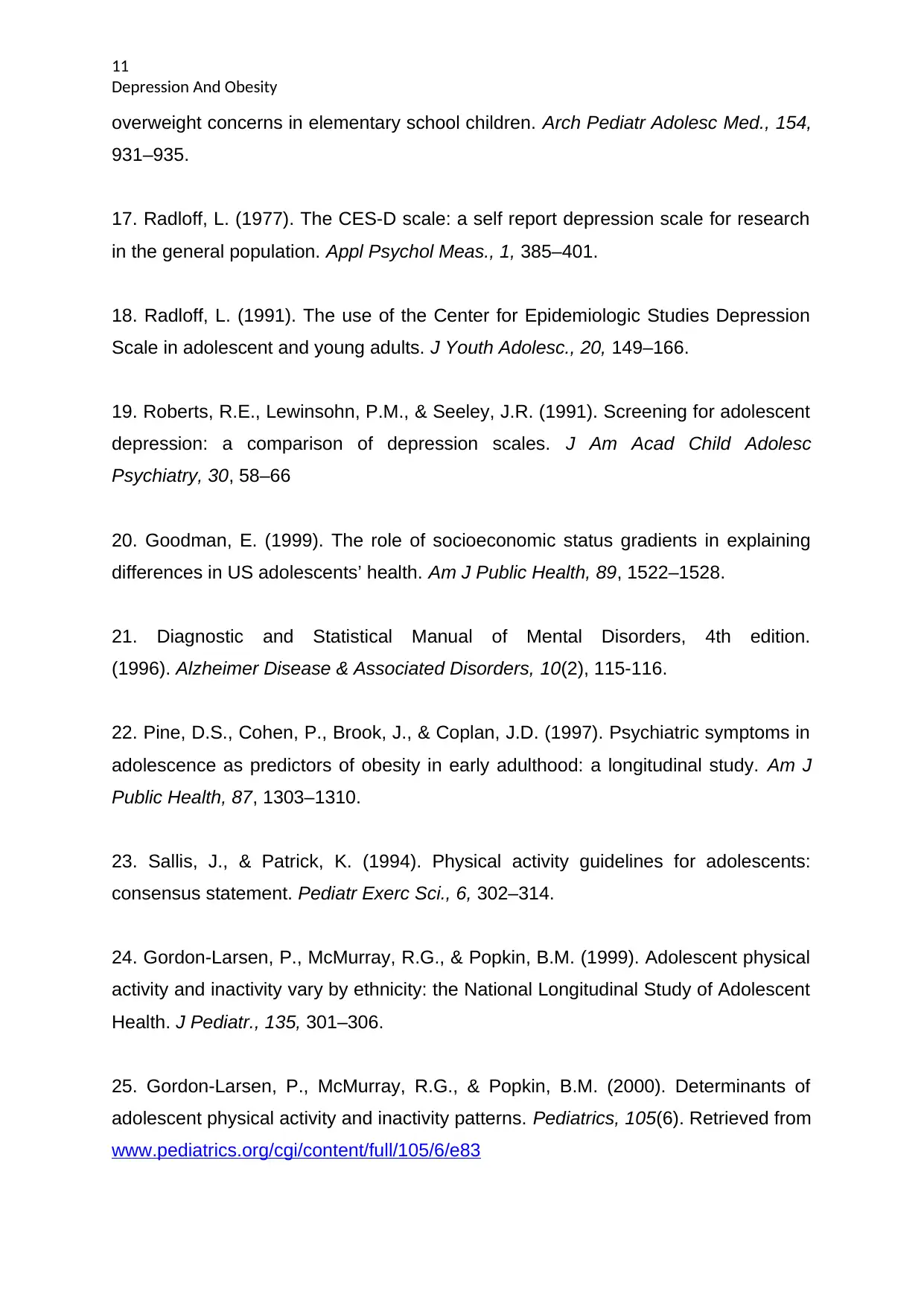
11
Depression And Obesity
overweight concerns in elementary school children. Arch Pediatr Adolesc Med., 154,
931–935.
17. Radloff, L. (1977). The CES-D scale: a self report depression scale for research
in the general population. Appl Psychol Meas., 1, 385–401.
18. Radloff, L. (1991). The use of the Center for Epidemiologic Studies Depression
Scale in adolescent and young adults. J Youth Adolesc., 20, 149–166.
19. Roberts, R.E., Lewinsohn, P.M., & Seeley, J.R. (1991). Screening for adolescent
depression: a comparison of depression scales. J Am Acad Child Adolesc
Psychiatry, 30, 58–66
20. Goodman, E. (1999). The role of socioeconomic status gradients in explaining
differences in US adolescents’ health. Am J Public Health, 89, 1522–1528.
21. Diagnostic and Statistical Manual of Mental Disorders, 4th edition.
(1996). Alzheimer Disease & Associated Disorders, 10(2), 115-116.
22. Pine, D.S., Cohen, P., Brook, J., & Coplan, J.D. (1997). Psychiatric symptoms in
adolescence as predictors of obesity in early adulthood: a longitudinal study. Am J
Public Health, 87, 1303–1310.
23. Sallis, J., & Patrick, K. (1994). Physical activity guidelines for adolescents:
consensus statement. Pediatr Exerc Sci., 6, 302–314.
24. Gordon-Larsen, P., McMurray, R.G., & Popkin, B.M. (1999). Adolescent physical
activity and inactivity vary by ethnicity: the National Longitudinal Study of Adolescent
Health. J Pediatr., 135, 301–306.
25. Gordon-Larsen, P., McMurray, R.G., & Popkin, B.M. (2000). Determinants of
adolescent physical activity and inactivity patterns. Pediatrics, 105(6). Retrieved from
www.pediatrics.org/cgi/content/full/105/6/e83
Depression And Obesity
overweight concerns in elementary school children. Arch Pediatr Adolesc Med., 154,
931–935.
17. Radloff, L. (1977). The CES-D scale: a self report depression scale for research
in the general population. Appl Psychol Meas., 1, 385–401.
18. Radloff, L. (1991). The use of the Center for Epidemiologic Studies Depression
Scale in adolescent and young adults. J Youth Adolesc., 20, 149–166.
19. Roberts, R.E., Lewinsohn, P.M., & Seeley, J.R. (1991). Screening for adolescent
depression: a comparison of depression scales. J Am Acad Child Adolesc
Psychiatry, 30, 58–66
20. Goodman, E. (1999). The role of socioeconomic status gradients in explaining
differences in US adolescents’ health. Am J Public Health, 89, 1522–1528.
21. Diagnostic and Statistical Manual of Mental Disorders, 4th edition.
(1996). Alzheimer Disease & Associated Disorders, 10(2), 115-116.
22. Pine, D.S., Cohen, P., Brook, J., & Coplan, J.D. (1997). Psychiatric symptoms in
adolescence as predictors of obesity in early adulthood: a longitudinal study. Am J
Public Health, 87, 1303–1310.
23. Sallis, J., & Patrick, K. (1994). Physical activity guidelines for adolescents:
consensus statement. Pediatr Exerc Sci., 6, 302–314.
24. Gordon-Larsen, P., McMurray, R.G., & Popkin, B.M. (1999). Adolescent physical
activity and inactivity vary by ethnicity: the National Longitudinal Study of Adolescent
Health. J Pediatr., 135, 301–306.
25. Gordon-Larsen, P., McMurray, R.G., & Popkin, B.M. (2000). Determinants of
adolescent physical activity and inactivity patterns. Pediatrics, 105(6). Retrieved from
www.pediatrics.org/cgi/content/full/105/6/e83
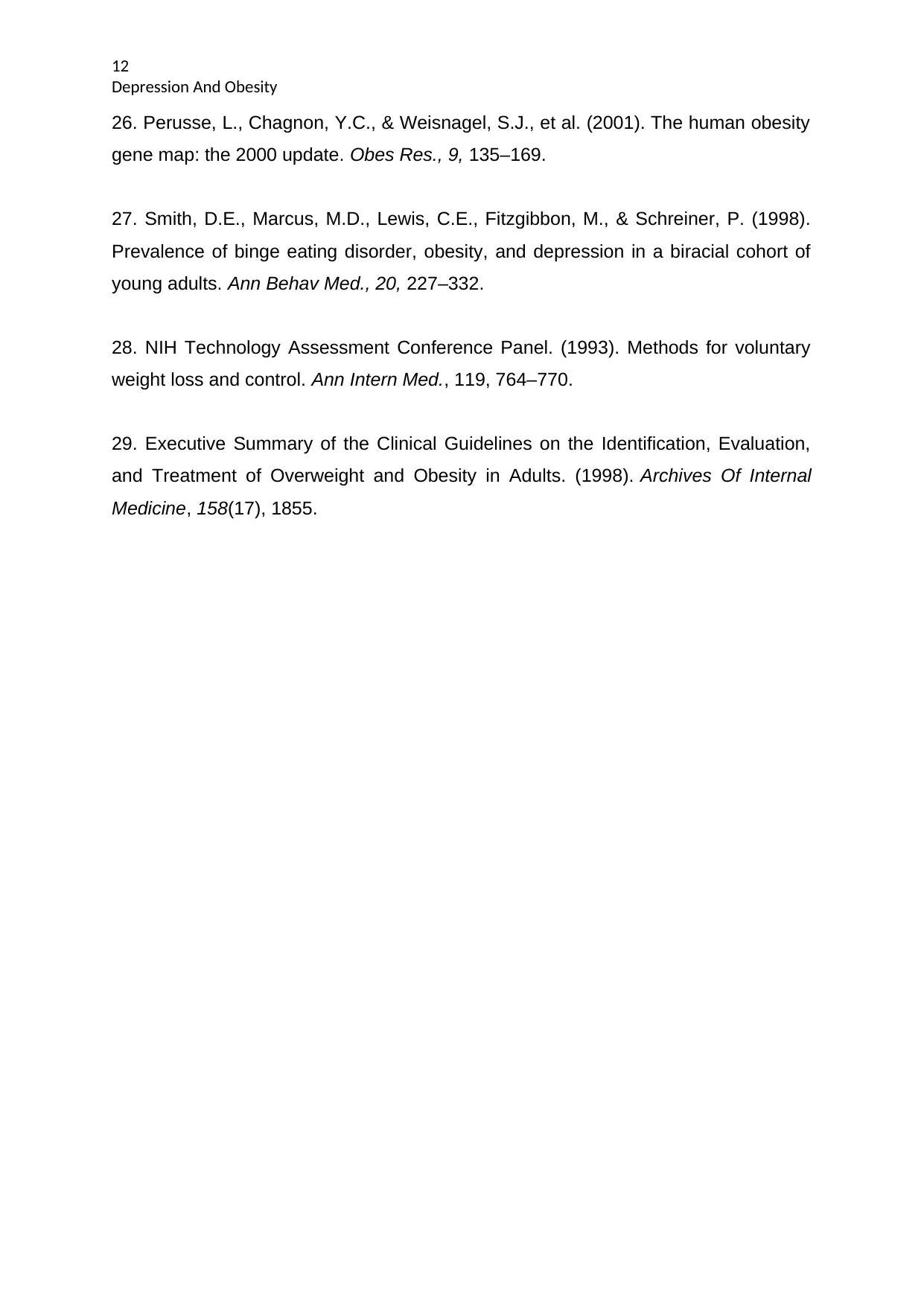
12
Depression And Obesity
26. Perusse, L., Chagnon, Y.C., & Weisnagel, S.J., et al. (2001). The human obesity
gene map: the 2000 update. Obes Res., 9, 135–169.
27. Smith, D.E., Marcus, M.D., Lewis, C.E., Fitzgibbon, M., & Schreiner, P. (1998).
Prevalence of binge eating disorder, obesity, and depression in a biracial cohort of
young adults. Ann Behav Med., 20, 227–332.
28. NIH Technology Assessment Conference Panel. (1993). Methods for voluntary
weight loss and control. Ann Intern Med., 119, 764–770.
29. Executive Summary of the Clinical Guidelines on the Identification, Evaluation,
and Treatment of Overweight and Obesity in Adults. (1998). Archives Of Internal
Medicine, 158(17), 1855.
Depression And Obesity
26. Perusse, L., Chagnon, Y.C., & Weisnagel, S.J., et al. (2001). The human obesity
gene map: the 2000 update. Obes Res., 9, 135–169.
27. Smith, D.E., Marcus, M.D., Lewis, C.E., Fitzgibbon, M., & Schreiner, P. (1998).
Prevalence of binge eating disorder, obesity, and depression in a biracial cohort of
young adults. Ann Behav Med., 20, 227–332.
28. NIH Technology Assessment Conference Panel. (1993). Methods for voluntary
weight loss and control. Ann Intern Med., 119, 764–770.
29. Executive Summary of the Clinical Guidelines on the Identification, Evaluation,
and Treatment of Overweight and Obesity in Adults. (1998). Archives Of Internal
Medicine, 158(17), 1855.
⊘ This is a preview!⊘
Do you want full access?
Subscribe today to unlock all pages.

Trusted by 1+ million students worldwide
1 out of 12
Related Documents
Your All-in-One AI-Powered Toolkit for Academic Success.
+13062052269
info@desklib.com
Available 24*7 on WhatsApp / Email
![[object Object]](/_next/static/media/star-bottom.7253800d.svg)
Unlock your academic potential
Copyright © 2020–2026 A2Z Services. All Rights Reserved. Developed and managed by ZUCOL.





